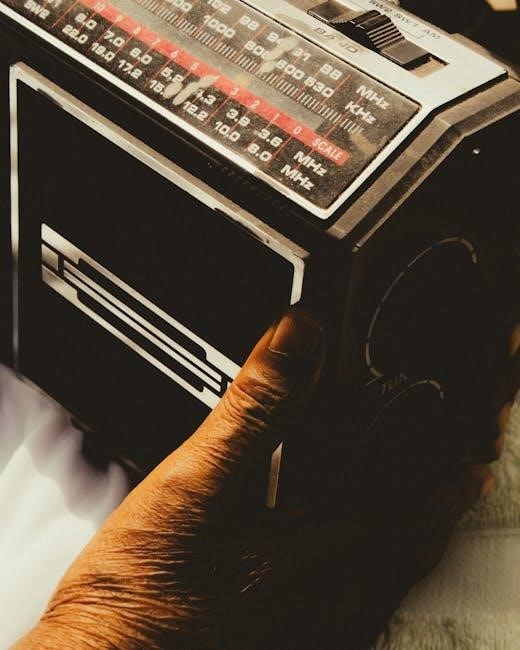The Boss RC-30 Loop Station is a powerful dual-track looper designed for musicians seeking versatility in looping. It offers 99 phrase memories, 3 hours of recording, and a built-in rhythm section. The manual provides essential guidance for optimal use, ensuring users can unlock its full creative potential.
1.1 Overview of the RC-30 Loop Station
The Boss RC-30 Loop Station is a dual-track looper pedal offering advanced looping capabilities for musicians. It features two synchronized stereo tracks with dedicated volume faders and track-select buttons, enabling precise control over complex compositions. With 99 phrase memories and up to 3 hours of recording time, it provides ample space for creativity. The built-in rhythm section and multiple input options (guitar, mic, AUX) further enhance its versatility. The RC-30 is designed to inspire musicians, from practice to performance, making it a comprehensive tool for loop-based music creation.
1.2 Importance of the Manual for Optimal Usage
The manual is essential for unlocking the full potential of the Boss RC-30 Loop Station. It provides detailed instructions for operating the device, from basic recording techniques to advanced features like built-in effects and rhythm sections. The manual also covers troubleshooting common issues, such as audio playback problems or USB connectivity, ensuring smooth operation. By following the manual, users can maximize the RC-30’s capabilities, explore creative possibilities, and maintain the device properly. Accessing the manual online or via PDF ensures users always have guidance at their fingertips.

Key Features of the Boss RC-30
The Boss RC-30 Loop Station offers dual-track looping, 99 phrase memories, and 3 hours of recording time. It features a built-in rhythm section and multiple input options for enhanced creativity and versatility.
2;1 Dual-Track Looper with Stereo Tracks
The Boss RC-30 features a dual-track looper with stereo tracks, allowing musicians to create complex, layered compositions. Each track has dedicated volume faders and track-select buttons for precise control. The stereo capability ensures high-quality audio reproduction, making it ideal for detailed soundscapes. This feature enables seamless switching between tracks and synchronization for perfect timing. Musicians can build intricate loops with ease, whether for live performance or studio recording, making the RC-30 a versatile tool for creative expression.
2.2 99 Phrase Memories and 3 Hours of Recording Time
The Boss RC-30 offers 99 phrase memories, allowing users to store and organize their loops efficiently. With up to 3 hours of recording time, musicians can create extended compositions without running out of space. This feature is ideal for live performances, rehearsals, and studio sessions, providing ample flexibility for capturing and replaying complex musical ideas. The ability to save and recall loops ensures that creativity is never limited, making the RC-30 a reliable tool for both professionals and hobbyists alike.
2.3 Built-In Rhythm Section for Enhanced Creativity
The Boss RC-30 features a built-in rhythm section, offering a variety of drum patterns and grooves to enhance musical creativity. This feature allows users to practice, compose, and perform with professional-sounding accompaniment. The rhythm section supports multiple genres, from rock to jazz, making it versatile for diverse musical needs. Musicians can synchronize loops with rhythmic patterns, creating cohesive and engaging performances. The manual provides detailed guidance on how to utilize this feature effectively, ensuring users can unlock its full potential for inspired music-making.
2.4 Multiple Input Options (Guitar, Mic, AUX)
The Boss RC-30 offers versatile connectivity with multiple input options, including guitar, microphone, and AUX. Musicians can connect their guitar for instrument looping, use the MIC jack for vocal recordings, or link external devices via AUX for sampling. This flexibility allows for diverse sound sources to be incorporated into loops. The manual details how to optimize each input for high-quality recordings, ensuring users can explore a wide range of creative possibilities with ease and precision.

How to Use the Boss RC-30 Manual Effectively
The Boss RC-30 manual is available online as a free PDF, providing clear instructions for navigating controls, accessing features, and troubleshooting. It ensures optimal device operation.
3.1 Navigating the Manual for Beginners
The Boss RC-30 manual is a comprehensive guide designed to help users master the loop station. For beginners, it’s essential to start with the table of contents to understand the layout. Focus on key sections like Features, Quick Demo, and Five Things to Know to grasp the basics. The manual also includes detailed instructions for recording, playback, and customization. By following the step-by-step guides, new users can quickly familiarize themselves with the controls and functions, ensuring a smooth learning curve. Online resources and tutorials are also available for additional support.
3.2 Understanding the Layout and Controls
The Boss RC-30 features a user-friendly layout with dual-track controls, volume faders, and track-select buttons for intuitive operation. The interface includes a MIC jack, AUX IN, and rhythm section controls, enhancing creativity. The manual provides detailed diagrams and descriptions to help users understand each component. By familiarizing yourself with the controls, you can easily navigate functions like recording, playback, and customization. The manual also highlights key sections like Quick Demo and Five Things to Know, ensuring a smooth setup and operation experience. Online resources further support mastering the device.
3.3 Accessing the Manual Online or via PDF
The Boss RC-30 manual is readily available online as a free PDF download, ensuring easy access to operating instructions. Users can find it on official Boss websites or trusted manual repositories. The manual is provided in multiple languages, including English, Deutsch, Français, and Italiano, catering to a global audience. It is searchable and downloadable, making it convenient for musicians to reference anytime. The PDF format allows for easy navigation, with detailed sections covering setup, features, and troubleshooting. This ensures users can fully utilize the RC-30’s capabilities with clear guidance.

Setting Up the Boss RC-30
Unbox and set up the RC-30 by connecting your guitar, microphone, or AUX input. Update firmware and software for optimal performance and functionality.
4.1 Unboxing and Initial Setup
Unboxing the Boss RC-30 Loop Station is an exciting start to your looping journey. Carefully remove the pedal from its packaging and ensure all accessories, including the manual and power supply, are included. Place the RC-30 on a flat surface and connect your guitar, microphone, or AUX input as needed. Power on the device and familiarize yourself with the controls. The manual provides detailed instructions for initial setup, ensuring you’re ready to start looping right away. A stable power source and proper placement are key for optimal performance;
4.2 Connecting Inputs (Guitar, Microphone, AUX)
Connect your guitar directly to the 1/4-inch input for high-quality audio. For vocal recording, use the MIC jack with your microphone. The AUX IN allows you to connect external devices like audio players for backing tracks. Ensure all cables are securely plugged in to avoid signal loss. The RC-30 supports simultaneous use of multiple inputs, enabling versatile recording options. Refer to the manual for optimal input level settings to achieve the best sound quality during looping sessions.
4.3 Updating Firmware and Software
Regularly updating the RC-30 firmware and software ensures optimal performance. Visit the official BOSS website to download the latest system updates, such as Version 1.60. Use BOSS TONE STUDIO (available for Windows and macOS) to install updates via USB. Connect the RC-30 to your computer, launch the software, and follow on-screen instructions. Always refer to the manual for detailed steps. Updating ensures access to new features and bug fixes, keeping your looping experience smooth and up-to-date.

Recording and Playback on the RC-30
The RC-30 allows dual-track looping with dedicated volume faders for precise control. Record guitar, voice, or external audio, then playback seamlessly. Use the track-select buttons to manage loops effortlessly.
5.1 Basic Recording Techniques
Start by pressing the Rec footswitch to begin recording. The RC-30 allows you to capture high-quality audio from guitar, microphone, or AUX inputs. Use the Level knob to adjust input levels for optimal sound. You can record in two independent tracks, enabling layered loops. Press Rec again to stop, and use the Play switch to review your loop. The Rhythm guide helps maintain timing. Experiment with overdubbing by pressing Rec while playing back. Save your loops to phrase memories for later use, and transfer them to your computer via USB for further editing.
5.2 Managing Loops and Phrase Memories
The RC-30 offers 99 phrase memories, each capable of storing up to 3 hours of recording time. To store a loop, press the Rec button and select a memory location using the Phrase knob. Use the Level knob to adjust track volumes. You can organize loops into memories for easy access during performances. Selecting a memory is done via the Phrase button, allowing seamless transitions between loops. This feature ensures efficient management of your recordings, making it ideal for live use and creative composition.
5.3 Copying and Transferring Loops via USB
The RC-30 allows seamless transfer of loops to your computer via USB. Connect the device to your PC or Mac and use the Boss Tone Studio software to import or export WAV files. This feature enables easy backup of your recordings and integration with digital audio workstations. You can also load external loops into the RC-30, enhancing your creative possibilities. The USB interface ensures quick and reliable data transfer, making it ideal for musicians who want to expand their looping capabilities beyond the device itself.

Advanced Features of the RC-30
The RC-30 offers advanced features like built-in effects, track syncing, and a rhythm guide. These tools enhance loop creation, allowing for complex compositions and professional-grade performances.
6.1 Using Built-In Effects for Loop Enhancement
The RC-30 features a variety of built-in effects to enhance your loops, such as reverb, delay, and distortion. These effects can be applied to individual tracks or the entire mix, allowing for greater creativity and depth in your compositions. By using the manual, you can learn how to assign and adjust these effects to suit your musical style. This feature enables you to add professional-grade polish to your loops, making them more engaging and dynamic during live performances or practice sessions.
6.2 Syncing Tracks for Complex Compositions
The RC-30 allows seamless synchronization of its dual tracks, enabling musicians to create intricate and layered compositions. By syncing tracks, users can build complex loops with precise timing and alignment. This feature is particularly useful for crafting harmonies, rhythms, or overlapping melodies. The manual provides detailed instructions on how to set up and control track synchronization, ensuring that even novice users can master this advanced technique. Syncing tracks opens up endless creative possibilities, making the RC-30 a powerful tool for both live performance and studio recording.
6.3 Utilizing the Rhythm Guide for Practice
The RC-30’s built-in rhythm guide is a valuable tool for practice, offering a variety of time signatures and genres to accompany your loops. Musicians can improve timing and versatility by playing along with these rhythms. The manual details how to select and customize these patterns, ensuring they match your creative needs. This feature is especially useful for solo artists or those refining complex compositions; By integrating the rhythm guide, users can enhance their practice sessions and achieve professional-sounding performances with ease.

Customizing Your Looping Experience
The Boss RC-30 allows users to customize their looping experience by adjusting volume faders and track levels for precise control. Assign functions to external footswitches and create custom settings for personalized use.
7.1 Adjusting Volume Faders and Track Levels
The Boss RC-30 features independent volume faders for each track, allowing precise control over levels. Musicians can balance loops, adjust playback volumes, and fine-tune mixes. The track-select buttons enable isolating specific tracks for level adjustments. This customization ensures optimal audio quality and enhances live performances. Properly setting these levels is crucial for achieving a professional sound and maximizing the RC-30’s creative potential.
7.2 Assigning Functions to External Footswitches
The Boss RC-30 supports external footswitches, such as the FS-6, to expand control options. Users can assign functions like playback, stop, and undo/redo to these switches, enhancing live performance flexibility. This feature allows for seamless navigation and operation without needing to bend down, ensuring a smooth and professional experience. Assigning functions to external footswitches is straightforward, enabling musicians to customize their workflow and focus on their creativity during performances.
7.3 Creating and Saving Custom Settings
The Boss RC-30 allows users to create and save custom settings, ensuring personalized control over their looping experience. By adjusting volume faders, track levels, and effects, musicians can tailor the device to their unique needs. These settings can be saved for quick access during performances or practice sessions, enhancing efficiency and creativity. The ability to customize and save configurations makes the RC-30 highly adaptable, catering to diverse musical styles and preferences with ease and precision.
Troubleshooting Common Issues
Address audio playback problems, USB connectivity issues, and restore factory settings to resolve common challenges with the Boss RC-30, ensuring optimal performance and functionality.
8.1 Resolving Audio Playback Problems
Experiencing no sound or distorted audio? Check volume levels, ensure proper input connections, and verify track selection. Restart the RC-30 or restore factory settings if issues persist. Ensure firmware is updated to the latest version for optimal performance. Consult the manual for detailed troubleshooting steps to resolve audio playback problems effectively and maintain high-quality sound output during your looping sessions.
8.2 Fixing USB Connectivity Issues
Ensure the USB cable is securely connected to both the RC-30 and your computer. Use a high-quality USB cable to avoid connection problems. If your computer doesn’t recognize the device, restart both the RC-30 and your computer. Update or reinstall USB drivers from the BOSS website to ensure compatibility. Check your computer’s USB port functionality by testing with another device. If issues persist, consult the manual or contact BOSS support for further assistance.
8.3 Restoring Factory Settings
To restore the RC-30 to its factory settings, navigate to the System menu and select “Factory Restore.” Press and hold the footswitch for 2 seconds to confirm. This will reset all settings to their default values. Note that this process will erase all user data, including loops and custom settings. Ensure you have backed up important loops via USB before proceeding. Refer to the manual for detailed steps to avoid data loss and ensure a successful reset.

Maintenance and Care for the RC-30
Regularly clean the RC-30 with a soft cloth to prevent dust buildup. Update software periodically for optimal performance. Store the device in a protective case to avoid damage.
9.1 Cleaning the Device and Inputs
Regularly clean the RC-30 using a soft, dry cloth to remove dust and dirt. For stubborn marks, lightly dampen the cloth with water, but avoid moisture entering the device. Clean the input jacks with a dry cotton swab to ensure proper connectivity. Avoid harsh chemicals or abrasive materials that could damage the finish or harm the electronics. Always power off the device before cleaning and ensure it is completely dry before turning it on again for optimal performance and longevity.
9.2 Updating Software Regularly
Regular software updates are crucial for maintaining optimal performance of the RC-30. Check the BOSS website for the latest system updates, such as version 1.60, and install them using the BOSS TONE STUDIO software (available for Windows and macOS). Before updating, ensure your device is fully prepared and backed up. Updates often include new features, bug fixes, and performance improvements. Follow the manual’s instructions carefully to avoid errors during the process. Keeping your RC-30 updated ensures you have access to the latest enhancements and functionalities.
9.3 Storing the RC-30 Properly
Proper storage of the RC-30 is essential for maintaining its functionality and longevity. Always use the original box or a protective case to prevent physical damage. Store the device in a cool, dry place away from direct sunlight to avoid overheating and moisture exposure. Disconnect all cables when not in use to protect the inputs. Regularly cleaning the device before storage ensures dust and dirt don’t accumulate. By following these steps, you can preserve the RC-30’s performance and extend its lifespan.

The Boss RC-30 Loop Station is a versatile tool offering dual-track looping, built-in effects, and user-friendly controls. It empowers musicians to explore creative possibilities effortlessly.
10.1 Summary of Key Features and Benefits
The Boss RC-30 Loop Station offers dual-track looping with stereo tracks, 99 phrase memories, and 3 hours of recording time. It features a built-in rhythm section, multiple input options (guitar, mic, AUX), and USB connectivity for loop transfer. The manual provides detailed guidance for optimal use, ensuring musicians can fully utilize its creative potential. With its intuitive controls and robust features, the RC-30 is an essential tool for performers and composers seeking to enhance their looping capabilities.
10.2 Encouragement to Explore Creative Possibilities
Musicians, embrace the Boss RC-30 Loop Station’s versatility to unlock endless creative possibilities. With dual-track looping, 99 phrase memories, and a built-in rhythm section, this pedal empowers you to craft intricate compositions and enhance live performances. Experiment with layered sounds, sync tracks, and built-in effects to push your musical boundaries. Whether you’re a guitarist, vocalist, or producer, the RC-30 invites you to explore new dimensions of sound and creativity, making it an indispensable tool for both practice and performance.

Additional Resources
Explore official BOSS RC-30 tutorials, community forums, and user guides for deeper insights. Discover recommended accessories to enhance functionality and creativity with your loop station.
11.1 Official Boss RC-30 Tutorials and Guides
The official BOSS RC-30 tutorials and guides provide comprehensive instruction for mastering the loop station. Available online, these resources include detailed video demonstrations, step-by-step instructions, and a downloadable PDF manual. The tutorials cover basic functions, advanced features, and troubleshooting tips, ensuring users can fully utilize the RC-30’s capabilities. Additionally, a dedicated training guide offers insights into creative looping techniques and optimal setup configurations, helping musicians unlock the device’s full potential for live performance and studio recording.
11.2 Community Forums and User Groups
Community forums and user groups dedicated to the BOSS RC-30 offer valuable resources for musicians. These platforms allow users to share tips, ask questions, and collaborate on creative projects. Members often discuss troubleshooting, advanced techniques, and gear setups, fostering a supportive environment for learning. Many forums feature user-generated guides and tutorials, while others host discussions on optimizing the RC-30 for live performances and studio recordings. Engaging with these communities can enhance your looping experience and help you maximize the device’s potential.
11.3 Recommended Accessories for Enhanced Functionality
To enhance the functionality of the BOSS RC-30, consider investing in recommended accessories. A dedicated FS-6 or FS-7 footswitch provides hands-free control, while a high-quality expression pedal allows for dynamic volume or effect adjustments. A reliable power supply (e.g., PSA-120 or PSA-240) ensures stable operation. Additionally, a USB cable is essential for transferring loops to your computer, and a backup memory card can expand storage for your creations. Finally, a durable carrying case protects your RC-30 during transport, ensuring it remains in optimal condition for performances and practice sessions.
